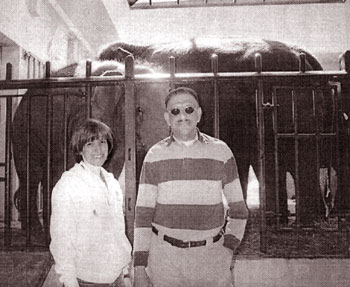|
dailynews |
|
|
|
|
|
OTHER LINKS |

|

|

|
Artificial insemination of a Lankan elephant in WashingtonELEPHANTS: March 2, 2006 enters another chapter in the history of Sri Lankan elephants as Shanthi, the Smithsonian National Zoo's female elephant was artificially inseminated. Shanthi is the mother of Kandula, the Zoo's four-year-old bull, who was also conceived by artificial insemination conducted by same team of scientists in February 2000. I was very privileged to be invited to the Zoo as an observer/guest by the Manager of the Elephant-House, Marie Galloway, who is an expert in elephant management and care.
During my visit I also had the opportunity of meeting with Dr. Janine Brown, an endocrinology and elephant expert at the Zoo. She has been monitoring Shanthi's estrus cycles via hormone analysis since 1981. She has been monitoring Shanthi's hormones to determine the best time for insemination, and based on the data, this weeks inseminations coincide with a specific hormone surge that causes ovulation. It will be four months, the length between elephant estrus cycles, before the Zoo's scientists can confirm through hormonal analyses, if Shanthi has conceived. Dr. Thomas Hildebrandt from the Institute for Zoo and Wildlife Research in Berlin was present to conduct the insemination procedure. This is the seventh attempt by Dr. Hildebrandt at the National Zoo since 1995, out of which five were unsuccessful due to poor quality semen and incorrect timing. The semen used must be collected within 12 to 24 hours before the procedure. We Sri Lankans, from the land of elephants, have not progressed in research to the levels that the West has performed. Pinnawela is our only elephant breeding grounds, and the Government should give more funds for projects of this nature. If the Sri Lankan bureaucracy looks for foreign-aid, there are many organisations such as the World Bank that will fund such projects. The Smithsonian National Zoo may be in a position to extend a helping hand, as they have the technology. It is made to understand that lots of funds that have been granted to the country have not been utilized, as proper project proposals have not been submitted on time, or not submitted at all. It is a shame to note that our agencies have done nothing whatsoever in this field. Pinnawela Elephant Orphanage is a very successful project of ours. We have very capable and knowledgeable personnel to handle advanced projects. This is an appeal to the President of Sri Lanka and to the Minister of Wild Life and Conservation to focus more attention on science and technology of this nature and get the best out of our technocrats. Our national treasure of elephants will be out of sight, as the captive number of elephants is very much on the decline, and there will come a day that we will not have any elephants to participate even in our religious ceremonies. ******************************** African and Asian elephantsToday there are only two species of elephants in the world - the Asian (Elephas maximus) and the African (Loxodonta africana).
There are two sub species of the African elephant, the African bush elephant (Loxodonta africana africana) and the African forest elephant (Loxodonta africana cyclotis). Some taxonomists feel that there is enough scientific evidence to treat both these sub species as two distinct species. The name Loxodonta means "slanting toothed" due to the lozenge-shaped ridges on top of the molars of the African elephant's teeth, which are not shared with the Asian species. The Asian elephant is smaller despite its specific name, maximus. The African elephant (Loxodonta) was widely distributed across much of Africa in prehistoric times. However they never extended their range outside the African continent. In contrast, the Asian Elephant (Elephas) appears to have evolved in Africa but later extended its range into Eurasia. The African and Asian elephants have distinct differences. |





